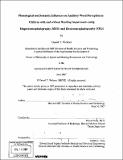Phonological and semantic influences on auditory word perception in children with and without reading impairments using magnetoencephalography (MEG) and electroencephalography (EEG)
Author(s)
Wehner, Daniel T
DownloadFull printable version (17.75Mb)
Other Contributors
Harvard University--MIT Division of Health Sciences and Technology.
Advisor
Maria Mody.
Terms of use
Metadata
Show full item recordAbstract
Children with dyslexia struggle with learning to read despite adequate intelligence, motivation, and schooling. Over the years, there has been a growing consensus about the role of phonological processing in reading disability. Poor readers typically do worse than their normal reading peers on tasks that require phonological processing which has been linked, directly or indirectly, to their speech perception abilities. The work in this thesis combined behavioral, MEG, and EEG methods to examine how normal and reading-impaired children, 7-13 years of age, perceive speech under varying degrees of phonological contrast (1 vs. 3 phonetic features). In a series of auditory word perception experiments, good and poor readers were found to do worse in accuracy and/or reaction times in phonologically similar (i.e., 1-feature contrast) than phonologically dissimilar (i.e., 2 or 3-feature contrast) conditions. Despite the similar behavioral performance and EEG responses for the two groups, a region of interest (ROI) based MEG approach revealed differences in the brain activation of the two groups in superior temporal regions at 140 to 300 ms. (cont.) In the auditory word discrimination task, differences in activation were found in good readers but not poor readers, as a function of the degree of phonological contrast, reflecting poor readers' lack of sensitivity to the phonological characteristics of the word stimuli. In the sentence plausibility judgment task, the impaired phonological processing abilities of the poor readers may have led them to rely more on top-down sentence context to perceptually disambiguate phonologically confusing terminal words, thereby deceiving them into accepting the phonologically similar incongruent sentences as being congruent. This may account for the poor reader group's reduced brain activation in the phonologically demanding condition in the sentence task. The results of the experiments are consistent with a phonological view of reading disability according to which children with reading impairments have poorly defined phonological representations.
Description
Thesis (Ph. D.)--Harvard-MIT Division of Health Sciences and Technology, 2007. Includes bibliographical references (p. 117-135).
Date issued
2007Department
Harvard University--MIT Division of Health Sciences and TechnologyPublisher
Massachusetts Institute of Technology
Keywords
Harvard University--MIT Division of Health Sciences and Technology.